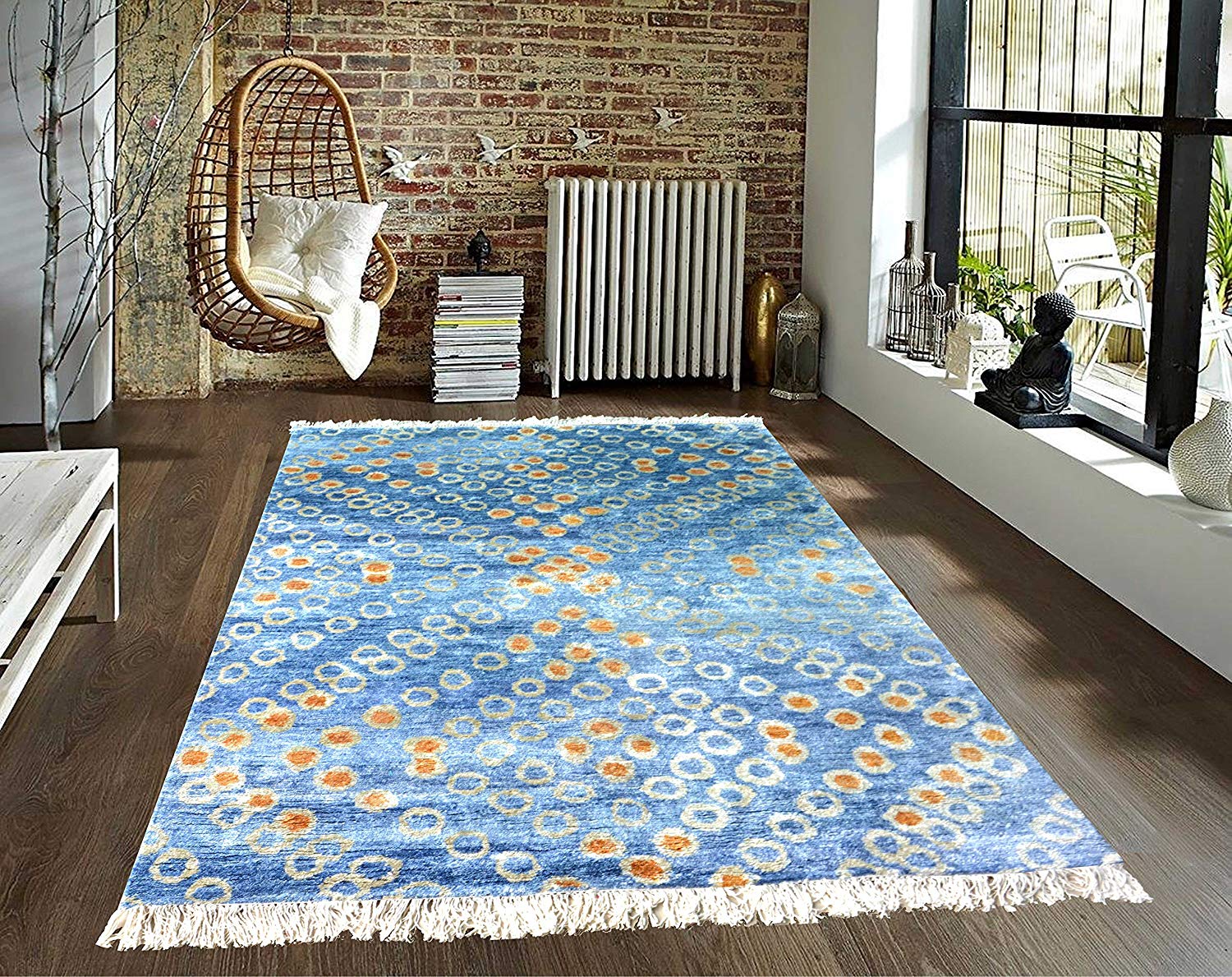Hand knotted carpets bring warmth and character to any space. These handcrafted pieces serve as the foundation of your room’s design, tying together furniture, colors, and decor elements into one cohesive look.
Getting the match right between your carpet and existing furnishings can feel challenging. The good news? With the right approach, you can create a balanced, inviting space that showcases both your carpet and furniture beautifully.
This guide walks you through the key considerations for pairing hand knotted carpets with your furniture and decor. You’ll learn practical tips for color coordination, pattern mixing, and placement that work in real homes.
Understanding Your Carpet’s Key Features
Before matching your carpet with furniture, take time to understand its characteristics. Four main elements will guide your decorating decisions.
Texture and Pile Height
Hand knotted carpets come in various textures, from smooth silk to chunky wool. High-pile carpets create a plush, cozy feeling that works well with comfortable furniture like sectional sofas and oversized chairs. Low-pile options offer a sleeker look that complements streamlined furniture pieces.
Consider how the carpet feels underfoot and how it looks from different angles. Silk carpets reflect light and appear more formal, while wool carpets absorb light for a softer, more casual appearance.
Color Palette
Identify the dominant colors in your carpet, plus any accent shades. Most hand knotted carpets feature a primary color that covers 60-70% of the design, with secondary colors making up the rest.
Note whether your carpet uses warm colors (reds, yellows, oranges) or cool colors (blues, greens, purples). This distinction will help you choose furniture and decor that harmonize with your carpet’s overall mood.
Pattern Style
Patterns range from geometric designs to floral motifs to abstract compositions. Bold, large-scale patterns make strong statements and work best as the room’s focal point. Subtle, small-scale patterns offer more flexibility and can support other design elements in the space.
Size and Shape
Rectangle carpets suit most furniture arrangements, while round carpets work well under circular dining tables or in conversation areas. The size determines how much floor space the carpet covers and influences furniture placement options.
Pairing Carpets with Different Furniture Styles
Your furniture style should guide carpet selection and placement for a cohesive look.
Modern and Contemporary Furniture
Clean-lined modern furniture pairs well with hand knotted carpets that have geometric patterns or solid colors. Choose carpets with crisp borders and structured designs rather than ornate floral patterns.
Neutral colored carpets—grays, beiges, or blacks—ground modern furniture without competing for attention. If you want more color, select carpets with bold, simple patterns that echo the furniture’s minimalist aesthetic.
Mid-Century Furniture
Mid-century pieces love hand knotted carpets with warm earth tones and organic patterns. Look for carpets in rust, gold, olive green, or burnt orange that complement the wood tones common in mid-century furniture.
Abstract or loosely geometric patterns work particularly well, as they match the era’s design sensibility without overwhelming the space.
Rustic and Farmhouse Furniture
Rustic furniture calls for hand knotted carpets with rich, warm colors and natural motifs. Deep reds, forest greens, and golden yellows create the cozy atmosphere that farmhouse and rustic styles embrace.
Floral patterns, paisley designs, or carpets with distressed finishes complement weathered wood furniture and vintage accessories perfectly.
Eclectic and Mixed Furniture
When you mix different furniture styles, your hand knotted carpet can serve as the unifying element. Choose a carpet that contains colors found throughout your various furniture pieces.
Neutral carpets with subtle patterns work best in eclectic spaces, allowing your diverse furniture collection to shine while providing visual cohesion.
Mastering Color Coordination
Color coordination makes or breaks the relationship between your hand knotted carpet and furniture.
Working with Wall Colors
Your carpet should harmonize with wall colors without matching exactly. If you have neutral walls, you can choose bold carpet colors. With colored walls, opt for carpets that contain similar hues but in different intensities.
For example, if your walls are sage green, look for carpets with green accents rather than predominantly green designs.
Coordinating with Upholstery
Pull colors from your carpet to use in throw pillows, curtains, and smaller upholstered pieces. This creates visual connections throughout the room without overwhelming the space with too much pattern or color.
If your sofa is neutral, add accent pillows in your carpet’s secondary colors. If your sofa has color or pattern, choose carpet colors that complement rather than compete.
Using Accessories as Bridges
Accessories help bridge the gap between carpet and furniture colors. Table lamps, artwork, vases, and books can echo carpet colors and create a pulled-together look.
This approach works particularly well when you want to introduce a colorful hand knotted carpet into a neutral room or vice versa.
Mixing and Matching Patterns
Pattern mixing requires a light touch, but when done right, it creates visual interest and depth.
The 60-30-10 Rule
Use one pattern for 60% of the space (usually the carpet), another for 30% (perhaps curtains or a large piece of artwork), and a third accent pattern for 10% (throw pillows or small accessories).
This formula prevents pattern overload while creating a dynamic, layered look.
Scale Considerations
Mix patterns of different scales to avoid visual competition. If your hand knotted carpet has large motifs, pair it with smaller-scale patterns in pillows or window treatments.
Conversely, if your carpet features fine, detailed patterns, you can introduce larger-scale patterns in other elements.
Sticking to Similar Color Families
When mixing patterns, keep colors within the same family for cohesion. This allows you to play with different designs while maintaining visual harmony.
Size and Placement Guidelines
Proper sizing and placement make your hand knotted carpet look intentional and professional.
Living Room Placement
In living rooms, your carpet should extend beyond furniture groupings. Aim to have at least the front legs of sofas and chairs on the carpet, with coffee tables sitting completely on the carpeted surface.
For larger rooms, choose carpets that accommodate the full furniture grouping with 18-24 inches of carpet extending beyond the furniture on all sides.
Dining Room Sizing
Dining room carpets should extend at least 24 inches beyond the table on all sides. This ensures chairs remain on the carpet even when pulled out for seating.
Round tables work beautifully with round carpets, while rectangular tables pair naturally with rectangular carpets.
Bedroom Considerations
In bedrooms, you can place carpets completely under the bed with equal extension on all sides, or position them so they extend from the foot of the bed into the room’s seating area.
Smaller carpets work well on one side of the bed or in reading nooks within the bedroom.
Shopping Tips for Success
When you buy carpet online, request samples when possible. Seeing actual colors and textures helps you make better matching decisions than relying on photos alone.
Consider your room’s lighting when making selections. Natural light reveals true colors, while artificial lighting can shift how colors appear throughout the day.
Measure your space carefully and create a floor plan before shopping. This prevents costly sizing mistakes and helps you visualize how different carpet options will look in your specific room.
Take photos of your existing furniture and decor to reference while shopping. This helps you remember exact colors and patterns when comparing carpet options.
Creating Your Perfect Match
Matching hand knotted carpets with furniture and decor comes down to understanding proportions, colors, and patterns. Start with your carpet’s characteristics, consider your furniture style, and use color and pattern mixing principles to create a cohesive look.
Remember that the best interior design feels both intentional and comfortable. Trust your instincts about what feels right in your space, and don’t be afraid to take some time finding the perfect match. The right hand knotted carpet will serve as the foundation for a room you love for years to come.
















